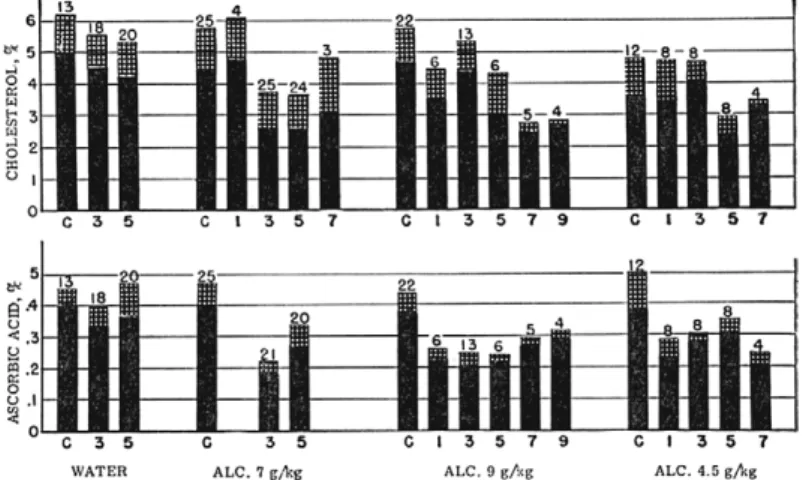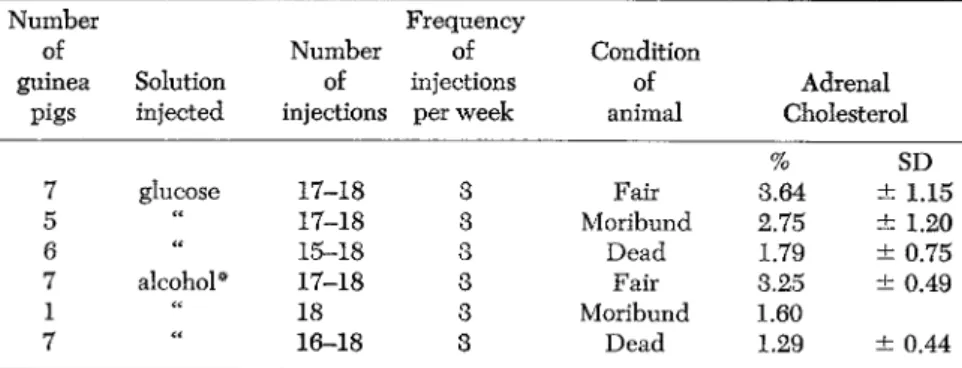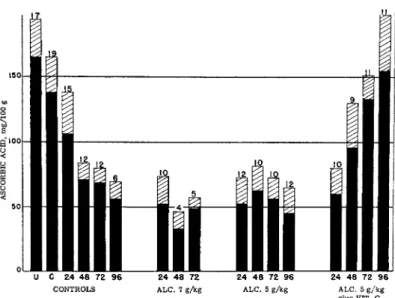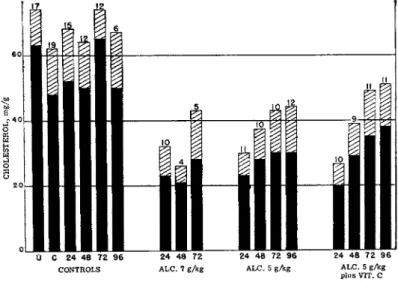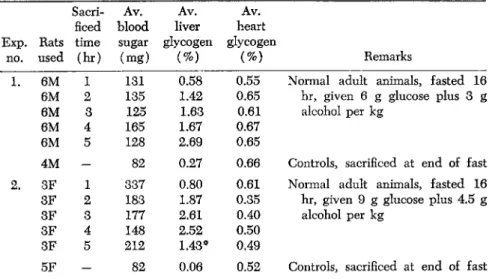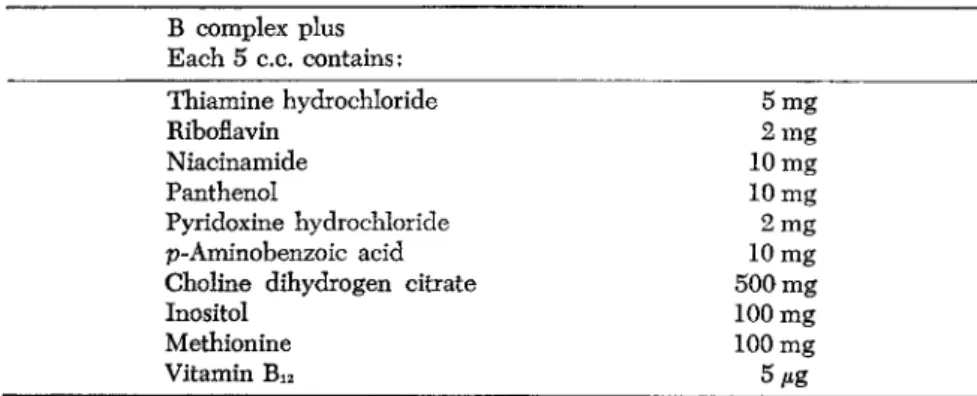MECHANISMS WITH APPLICATIONS TO THERAPY OF ALCOHOLICS *
E B B E C U R T I S H O F F A N D J O H N C. F O R B E S
Medical College of Virginia, Richmond, Virginia
1. The Action of Alcohol upon the Pituitary-Adrenal System 184 II. The Effect of Glucose Administration upon the Glycogenolytic Action
of Alcohol 189 III. The Effect of Polyvitamin Supplementation in the Diet of Alcoholics upon
Their Clinical Course 189
References 193
In this discussion we shall confine ourselves primarily to work done in our own laboratories at the Medical College of Virginia and the clinical services of the Division of Alcohol Studies and Rehabilitation, State Department of Health, Commonwealth of Virginia, located at the Medical College of Virginia. All the investigations to be reported here have been supported by the Division of Alcohol Studies and Rehabilita
tion. The studies to be presented can be conveniently divided into three main headings: (I) the action of alcohol upon the pituitary-adrenal system; (II) the effect of glucose administration upon the glycogen
olytic action of alcohol; and (III) the effect of polyvitamin supple
mentation in the diet of alcoholics upon their clinical course.
I. The action of alcohol upon the pituitary-adrenal system Several investigators have reported during the last few years that patients in an acute alcoholic state exhibit symptoms suggestive of impairment of adrenal function (Tintera and Lovell, 1949; Smith, 1950 a, Goldfarb and Berman, 1949). Smith (1950b; 1951) and Forbes and Duncan (1951) have shown that an intoxicating dose of alcohol in the experimental animal causes a striking drop in both the cholesterol and ascorbic acid content of the adrenal glands. That this effect is
* Grateful acknowledgment is made to the Committee on Problems of Alcohol, National Research Council, for Grants-in-Aid for a part of the animal experimental work.
184
mediated through the pituitary gland is indicated by the work of Smith (1950b) and of Forbes and Duncan (1951), who were unable to demonstrate any effect of the alcohol administration on the adrenal glands of the hypophysectomized rat. Some of the results obtained by Forbes and Duncan are shown in Figure 1. It will be seen that admin-
FIG. 1. The adrenal ascorbic acid and cholesterol levels following administration of water or an intoxicating dose of alcohol by stomach tube to fasted rats. The solid bars represent mean values expressed as per cent of wet adrenal tissue. The dotted areas indicate the positive half of the standard deviation. The numbers above the bars show the number of animals used; those below the bars the hours after alcohol or water administration at which the rats were sacrificed. C indicates values for control animals given neither alcohol nor water. From Thesis, G. M. Duncan, Medical Col
lege of Virginia, Richmond, Va., 1952.
istration of alcohol to intact fasted rats caused a drop in both the cholesterol and ascorbic acid content of the adrenal glands. The slightly lower values for ascorbic acid and cholesterol following the manipula
tive procedure are not statistically significant. The results of studies on hypophysectomized rats are shown in Table 1. It will be seen that in these animals alcohol administration exerted no demonstrable action.
Since alcohol administration caused such a large drop in the ascorbic acid content of the adrenal glands, experiments were carried out to determine whether repeated administration of intoxicating doses of alcohol would accelerate the rate of development of scurvy in guinea pigs (Forbes and Duncan, 1953a). Animals of comparable age and nutritional status were put on a scorbutogenic diet and divided into two
TABLE 1. Effect of Alcohol on Concentration of Ascorbic Acid and Cholesterol in Adrenal Glands of Hypophysectomized Rats
Procedure No. of animals Time* Ascorbic acid f Cholesterol f Alcohol, 7 g per kg 6 3 0.338 ± 0.031 6.25 ± 1.06 Alcohol, 7 g per kg 6 5 0.372 ± 0.096 5.82 ± 1.33 Water (controls) 6 3 0.356 ± 0.078 5.73 ± 1.11 Water (controls) 5 5 0.341 ± 0.066 5.89 ± 1.32 None (controls) 10
-
0.300 ± 0.055 6.34 ± 0.75* Hour after alcohol or water administration when sacrificed.
Averaged concentration in per cent of fresh tissue,
f Taken from Quart. J. Studies Ale. (1951) 12, 355-359.
groups. One group was given 4 gm. of alcohol per kilogram of body weight intraperitoneally, as a 10% solution in 5% glucose, three times a week for the duration of the experiment. The other group was given a comparable injection of the 5% glucose solution. The food consumption of this control group was restricted to the amount eaten by the cor
responding test animals. After a number of the animals from each group had died, the remaining animals were sacrificed, some of them being in what appeared to be a moribund condition. The cholesterol content of
TABLE 2. Effect of Repeated Intraperitoneal Injections of Alcohol on the Cholesterol Concentration of the Adrenals of Guinea Pigs on a Scorbutogenic Diet for Six Weeks.
Number Frequency
of Number of Condition
guinea Solution of injections of Adrenal pigs injected injections per week animal Cholesterol
% SD
7 glucose 17-18 3 Fair 3.64 ± 1.15
5 17-18 3 Moribund 2.75 ± 1.20
6 ** 15-18 3 Dead 1.79 ± 0.75
7 alcohol* 17-18 3 Fair 3.25 ± 0.49
1 18 3 Moribund 1.60
7 16-18 3 Dead 1.29 ± 0.44
* 10% solution of 95% alcohol in 5% glucose, dose level 4 g/kg Taken from Quart. J. Studies Ale. (1953) 14, 540-44.
the adrenal glands was determined in each case. The experimental data are shown in Table 2. It will be seen that the number of animals that died was roughly the same in each group. The cholesterol content of the
adrenal glands of the animals sacrificed in a fair condition, though below normal for guinea pigs, was approximately the same in each group.
The low adrenal cholesterol content of the animals that died or were sacrificed in what we believed to be a moribund condition indicates that marked adrenal stimulation preceded death. This agrees with the work of Clayton and Prunty (1951), who found a great increase in 17-ketos- teroid excretion during the terminal stages of scurvy in guinea pigs.
These results indicate that repeated alcoholic intoxication does not, in the guinea pig, increase the animal's ascorbic acid requirement. It would thus appear that the decrease of adrenal ascorbic acid that results from the intoxicating condition is not associated with any appreciable loss of ascorbic acid to the body. Our animal studies have given us no information about whether or not a high intake of vitamin C is of value in the treatment of alcoholic patients. Our general impression is that
U C 24 4 8 72 96 24 4 8 72 24 4 8 72 96 24 48 72 9 6 CONTROLS ALC. 7 gAg ALC. 5 g/kg ALC. 5 g/kg
plus VIT. C
FIG. 2. Changes in the levels of adrenal ascorbic acid following oral administra
tion of alcohol to fasted guinea pigs. The solid bars represent mean values expressed as milligrams per 100 g of wet adrenal tissue. Cross-barred areas indicate the positive half of the standard deviation. Numbers above the bars indicate the number of ani
mals used; those under the bars show the hours after alcohol administration at which the animals were sacrificed, except the first two bars in the control group, which were sacrificed unfasted and after a 16-hour fast, respectively. Sodium ascorbate, 50 mg, injected intraperitoneally with the alcohol and at 24-hour intervals thereafter. Pellets fed 24 hours after alcohol. Taken from Quart J. Studies Ale. (1953) 14, 22-27.
it probably is. Since the normal adrenal gland has such a high level of this vitamin, it is natural to assume that it is probably involved in some adrenal function. Studies in our laboratories show that neither prior nor concurrent administration of sodium ascorbate to guinea pigs inhibits the effect of an intoxicating dose of alcohol on the adrenal ascorbic acid and cholesterol content. However, its administration accel
erates the rate at which the ascorbic acid and cholesterol content tend to return to normal concentrations (Forbes and Duncan, 1953b). Some experimental results are shown in Figures 2 and 3. As would be ex-
CONTROLS ALC. 7 g/kg ALC. 5 g/kg ALC. 5 gAg plus VIT. C
FIG. 3. Changes in the levels of adrenal cholesterol following oral administration of alcohol to fasted guinea pigs. The solid bars represent mean values expressed as milligrams per gram of wet tissue. Cross-barred areas indicate the positive half of the standard deviation. Numbers above the bars indicate the number of animals used;
those under the bars show the hours after alcohol administration at which the animals were sacrificed, except the first two bars in the control group, which were sacrificed unfasted and after a 16-hour fast, respectively. Sodium ascorbate, 50 mg, injected intraperitoneally with the alcohol and at 24-hour intervals thereafter. Pellets fed 24 hours after alcohol. Taken from Quart. }. Studies Ale. (1953) 14, 22-27.
pected, the ascorbic acid, after the initial fall, rose rather rapidly to normal in those animals given sodium ascorbate. The rate at which the cholesterol rose toward normal was also somewhat faster in the animals receiving sodium ascorbate than in the corresponding controls.
TABLE 3. Effect of Alcohol on Blood Sugar and Liver and Heart Glycogen Sacri Av. Av. Av.
ficed blood liver heart Exp. Rats time sugar glycogen glycogen
no. used (hr) (mg) (%) (%) Remarks
1. 6M 1 131 0.58 0.55 Normal adult animals, fasted 16 6M 2 135 1.42 0.65 hr, given 6 g glucose plus 3 g 6M 3 125 1.63 0.61 alcohol per kg
6M 4 165 1.67 0.67 6M 5 128 2.69 0.65
4M — 82 0.27 0.66 Controls, sacrificed at end of fast 2. 3F 1 337 0.80 0.61 Normal adult animals, fasted 16 3 F 2 183 1.87 0.35 hr, given 9 g glucose plus 4.5 g 3 F 3 177 2.61 0.40 alcohol per kg
3 F 4 148 2.52 0.50 3F 5 212 1.43* 0.49
5F _ 82 0.06 0.52 Controls, sacrificed at end of fast
* Low value due to a glycogen level of only 0.47% in one animal.
Taken from Quart. J. Studies Ale. (1950) 11, 373-380.
III. The effect of polyvitamin supplementation in the diet of alcoholics u p o n their clinical course
Williams' experimental elucidation of a relationship between nutrition and alcohol consumption in rats presents the important issue as to whether nutritional supplements may affect the use of alcohol in human
II. The effect of glucose administration u p o n the glycogenolytic action of alcohol
It has been shown that the administration of alcohol to animals, espe
cially to dogs, with adequate liver glycogen store, causes rapid glycogen- olysis with hyperglycemia. It consequently seemed of interest to determine if this effect of alcohol could be inhibited by the simultaneous administra
tion of glucose (Forbes and Duncan, 1950). The experimental results that are summarized in Table 3 show that, at least in the rat, such is the case. It will be seen that the oral administration of glucose along with the alcohol enabled the liver to lay down considerable glycogen in spite of the alcohol administration. This action of glucose on liver glycogen may explain to a considerable extent the beneficial effect of intravenous glucose in acute alcoholic intoxication.
alcoholic patients. In Williams' studies (1952), rats on a marginal diet were found to select a high alcohol intake. Addition of ample supplies of the better known Β vitamins, not including B1 2, reduced the number of animals who drank substantial amounts of alcohol. If Bi 2 was supplied in addition, about half the animals responded. Further reduction of the proportion of the animals using alcohol was effected by adding vitamins A, D, and C and a source of unsaturated fatty acids. When antibiotics and unidentified preparations from yeast were added, a high percentage of the animals had their appetites for alcohol abolished or at least greatly reduced.
In clinical trials of a specific vitamin supplement, Williams and his associates have reported cases in which compulsion to drink is presum
ably lost. Although the goal of total abstinence is presently almost univer
sally accepted for alcoholics, Williams' cases have convinced him that his vitamin supplementation has permitted several alcoholics to drink or not as they choose without danger of loss of control.
In our own service, a clinical investigation is under way to explore possible effects on the drinking pattern of our alcoholic patients of long- term administration of a polyvitamin formula. A preliminary report may be made at this time of the clinical course of 100 patients given the vitamin formula shown in Table 4 plus a supplement of ascorbic acid. Vitamins
TABLE 4 Β complex plus
Each 5 c.c. contains:
Thiamine hydrochloride 5 mg
Riboflavin 2 m g
Niacinamide 10 mg
Panthenol 10 mg
Pyridoxine hydrochloride 2mg
p-Aminobenzoic acid 10 mg
Choline dihydrogen citrate 500 mg
Inositol 100 mg
Methionine 100 mg
Vitamin B i2 5 > g
A, D, and Ε were not incorporated because of the difficulty of adding these vitamins to an aqueous solution. The 100 patients in question com
prised all patients admitted consecutively during a period in December 1951 and January and February 1952. The progress of these patients has
been compared with that of 100 control patients admitted consecutively during July, August, September, and October 1952. All patients in both the vitamin and the control series were nonpsychotic, chronic alcoholics accepted on a voluntary basis. Therapy involved a period of about 7 to 10 days in the ward of our Division at the Medical College of Virginia Hospital, and included medical and psychological diagnostic work-up as indicated as well as individual and group psychotherapy, social work, and other counselling. The treatment plan for all patients included out
patient follow-up in our clinic for at least a year. Some patients in both the vitamin and control groups voluntarily took disulfiram (tetraethyl- thuram disulfide, Antabuse) as a part of therapy while in hospital.
Patients in the vitamin group received orally 15 cc. of the formula (Table 4) a day plus 100 mg of ascorbic acid. Following hospitalization, they continued each day to take 10 cc of the formula plus 100 mg of ascorbic acid. Patients were encouraged to take the supplement as long as they continued to attend the clinic. It was explained to the patients that they were taking vitamins but any particular possible effect was not suggested.
Patients in the control series received in hospital daily intramuscular injections of 1 cc of a solution of crystalline factors of vitamin Β (Plebex, Wyeth; each cubic centimeter containing thiamine hydrochloride 10 mg, riboflavin 2 mg, niacinamide 100 mg, pyridoxine 5 mg, calcium panto
thenate 5 mg). Also, each control patient received orally a daily amount of 100 mg of ascorbic acid while in hospital. On leaving the hospital and during the subsequent period of outpatient follow-up, the control patients received no supplementary vitamins. None of these patients knew of the vitamin series.
It is noted that the vitamin and the control groups were selected at different times of the year. This was done because of the difficulty in the service of designing a study in which placebos could successfully be given to alternate patients on the ward. All patients in the present groups have been evaluated after approximately 18 months of treatment.
Patients have been assigned to classes according to the following scheme of classification:
Class I comprises patients reporting total abstinence since the onset of treatment.
Class II includes patients who have maintained abstinence with but a single relapse.
Class III includes those patients who have not maintained abstinence
but who have shown improvement as measured by wider spacing of drinking sprees, better work record, and happier adjustment in home and community.
Class IV consists of patients in whom no improvement can be seen.
Class NT comprises patients who discontinued treatment through self-discharge or other means.
Class NC contains those patients whose status cannot be evaluated since contact with them has been lost. It may be reasonably assumed that classes NT and NC represent, for the most part, therapeutic failure.
Results of therapy in the vitamin and control groups over an 18- month period from the onset of treatment are given in Table 5.
TABLE 5. Comparison of results of therapy between 100 alcoholic patients receiving long-term vitamin supplement and 100 control cases
Class Vitamin group Control group
% %
I 24 17
II 17 24
III 38 29
IV 10 14
NT 1 1
NC 10 15
The six classes of the vitamin group tested with the chi-square test against the control group showed χ2 = 8.97 with 5 degrees of freedom with Ρ between 0.10 and 0.20. Summating classes I, II, and III (im
proved) and IV, NT, and NC (unimproved) and testing the improved and unimproved vitamin patients against the controls showed χ2 = 3.44 with 1 degree of freedom and a Ρ value between 0.05 and 0.10. f-tests were made for each of the six classes in the vitamin group against the corresponding classes of the control group with the following results:
Class I t = 1.23; Ρ greater than 0.10 Class II t = 1.23; Ρ greater than 0.10 Class III t = 1.36; Ρ greater than 0.10 Class IV t = 0.87; Ρ greater than 0.10
Class NT t not estimated since value was same in both groups.
Class NC t = 1.07; Ρ greater than 0.10
Generally speaking, the statistical analysis (revealing Ρ values greater than 0.05) suggests that the differences between the vitamin and control
groups cannot be confidently assigned to an effect of the vitamins but may be explained by random variation. The only statistic that has a Ρ value near 0.05 is the χ2 of 3.44, where it approaches a level that would be considered significant. We may conclude, therefore, that our studies so far do not demonstrate a statistically valid difference between our vitamin and control groups according to the classification selected.
Further studies with additional patients are in progress.
It is our clinical impression that patients in the vitamin group experi
enced a greater sense of well-being than those in the control group. We could elicit no clinical evidence that the patients of the vitamin or con
trol groups acquired any degree of control over their use of alcohol.
Our experience demonstrates clinically the value of vitamin supple
mentation during the initial hospitalization period as well as during a prolonged period thereafter in enhancing the sense of well-being.
ACKNOWLEDGMENT
Grateful acknowledgment is made to Dr. Murray G. Mitts, Research Assistant, Department of Neurological Science, Medical College of Virginia, for carrying out statistical analyses of the patient groups reported here.
References
Clayton, Β. E . , and Prunty, F. T. G. (1951). Brit. Med. J. 2, 927.
Forbes, J. C , and Duncan, G. M. (1950). Quart. J. Studies Ale. 11, 373.
Forbes, J. C , and Duncan, G. M. (1951). Quart. J. Studies Ale. 12, 355.
Forbes, J , C , and Duncan, G. M. (1953a). Quart. J. Studies Ale. 14, 540.
Forbes, J. C , and Duncan, G. M. (1953b). Quart. J. Studies Ale. 14, 22.
Goldfarb, A. I., and Berman, S. (1949). Quart. J. Studies Ale. 10, 415.
Lovell, H. W., and Tintera, J. W. (1951). Geriatrics 6, 1.
Smith, J. J. (1950a). Quart. J. Studies Ale. 11, 290.
Smith, J. J. (1950b). Ν. Y. State J. Med. 50, 1704.
Smith, J. J. (1951). /. Clin. Endocrinol. 11, 792.
Tintera, J. W., and Lovell, H. W. (1949). Geriatrics 4, 274.
Williams, R. J. (1952). /. Clin. Nutrition 1, 32.
